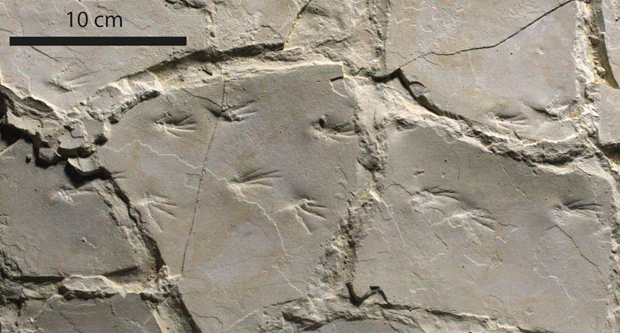Rhamphorhynchids – “Good Climbers and Rare Walkers”
One of the great mysteries regarding the Pterosauria may have finally be solved. Palaeontologists are one “step” closer to better understanding how these flying reptiles moved about on the ground. Researchers studying six pterosaur trackways preserved in the sandstone that once comprised part of a Late Jurassic beach have been able to examine the locomotive abilities of non-pterodactyloid pterosaurs for the first time.
Fossilised Pterosaur Tracks
This is a big deal, tracks of pterosaurs have been known about for some time, but all the trace fossils suggesting tracks up until now were believed to have been made by pterodactyloid pterosaurs, (Pterodactyloidea), essentially flying reptiles with short tails, relatively long metacarpal bones and a fifth toe that is greatly reduced or absent. Virtually nothing was known about the terrestrial abilities of other types of pterosaur that dominated the skies of the Jurassic, the dimorphodonts, Anurognathidae and the rhamphorhynchids for example.
However, scientists from the remarkable Musée de la Plage aux Ptérosaures, writing in the academic journal “Geobios”, describe six trackways related to three non-pterodactyloid new ichnotaxa and determine that these animals moved quadrupedally and that they were quite at home on the ground.
A Life Reconstruction of a Rhamphorhynchid Pterosaur Walking Across a Beach
Picture credit: Mark Witton
“Good Climbers and Bad Walkers”
Over the last two hundred years or so, a variety of theories have been put forward by palaeontologists regarding the way in which these flying reptiles moved about on the ground. For most of that time, these ideas were based on anatomical analysis of fossil bones. Trackways preserving evidence of a flying reptile moving about on the ground were exceptionally rare. Ironically, when such evidence did come to light, such as the trackway found in Wyoming in 1952 (Sundance Formation), these trace fossils received little scientific scrutiny.
The lack of tracks from non-pterodactyloid pterosaurs preserved in the fossil record, led many palaeontologists to believe that these animals rarely left the trees or the water and moved around on land. When they did, it was thought that they would have been clumsy and slow-moving, very vulnerable to predation.
A Non-pterodactyloid Trackway from the Upper Jurassic (Plage aux Ptérosaures)
Picture credit: Musée de la Plage aux Ptérosaures/Geobios
“The Pterosaur Beach of Crayssac”
The fossil finds come from the remarkable “la Plage aux Ptérosaures” (the pterosaur beach), located close to the village of Crayssac in the Occitanie region of south-western France. The site provides a trace fossil record of activity on a Late Jurassic beach around 150 million years ago (lower Tithonian faunal stage). Both dinosaur and pterosaur trackways are preserved.
The authors of the scientific paper, conclude that the tracks may have been made by rhamphorhynchids and they propose that non-pterodactyloids, at least during the Late Jurassic, were quadrupedal with digitigrade hands and plantigrade to digitigrade feet. Analysis of the tracks indicates that these animals were good walkers, even if their hind legs were hampered by the uropatagium (the membrane of skin that spanned the back legs). The idea that these types of flying reptiles were “good climbers but bad walkers”, seems to have been refuted.
Studying the Pterosaur Tracks
The authors state that based on this new study and contrary to current hypotheses, non-pterodactyloid pterosaurs seem to have been good walkers even though their trackways are very rare or unidentified to date. Each of the trackways is around a metre in length, the individual prints measuring approximately three centimetres long. Jean-Michel Mazin and his co-author Joane Pouech (from the museum at la Plage aux Ptérosaures), were aware of the significance of these trace fossils as pterodactyloids tracks tend to produce four toe marks in the trace fossil, whereas, non-pterodactyloids had five toes, so five toe marks would be expected in the majority of the hind prints.
Pterosaur expert Mark Witton provides a well-written and comprehensive overview of pterosaur anatomy and discusses the theories associated with their terrestrial locomotion in his excellent book simply entitled “Pterosaurs”.
A review of this publication can be found here: Pterosaurs by Mark Witton – a book review.
The Front Cover of the Comprehensive Book on Pterosaurs by Mark Witton
The scientific paper: “The first non-pterodactyloid pterosaurian trackways and the terrestrial ability of non-pterodactyloid pterosaurs” by Jean-Michel Mazin and Joane Pouech published in Geobios.
The Everything Dinosaur website: Everything Dinosaur.










Leave A Comment